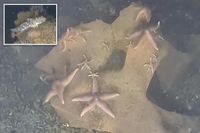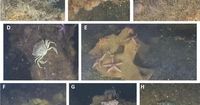On September 25, 2025, scientists made a discovery in the cold depths of the Baltic Sea that turned expectations upside down. Instead of finding a barren wasteland around the rusting relics of World War II explosives, an undersea submersible revealed a thriving community of crabs, worms, fish, and even starfish living directly on the very surfaces once thought deadly to marine life. The findings, published in the Journal of Communications Earth and Environment, are challenging long-held assumptions about the ecological impact of wartime munitions, and they’re prompting new questions about nature’s resilience in the face of human-made hazards.
This remarkable underwater survey focused on a notorious weapons dumpsite in the Bay of Lübeck, just off the coast of Germany. Here, remnants of V-1 flying bombs—once deployed by Nazi Germany—now serve as unlikely homes for a host of sea creatures. According to AP, the research team, led by Andrey Vedenin of the Senckenberg Research Institute in Germany, was initially prepared for the worst. “We were prepared to see significantly lower numbers of all kinds of animals,” Vedenin explained. “But it turned out the opposite.”
That surprise wasn’t just a matter of a few stray animals. The submersible’s cameras documented networks of anemones, starfish, and other marine life clinging to the hard, metallic surfaces of the abandoned warheads. In fact, the density of life was greater on the explosives than in the surrounding seabed, which is mostly flat, sandy, and muddy. Why would sea creatures flock to such a hazardous place?
The answer, it seems, lies in the unique landscape of the Baltic Sea. Over the centuries, stones and boulders were fished out for construction projects, leaving precious few hard surfaces for marine organisms to anchor themselves. As a result, the old munitions provide rare real estate. “The hard surfaces of the explosives provide anchoring points for marine life in an otherwise flat, sandy, and muddy seabed,” Vedenin told AFP. In a twist of fate, the very presence of chemical contamination and explosives has kept most human activity at bay, creating a sort of accidental sanctuary for these creatures.
Germany’s waters alone are estimated to contain roughly 1.6 million tons of discarded weapons, mostly from the two world wars of the 20th century, according to Devdiscourse. Many of these explosives still contain chemical agents, TNT, and even nuclear remnants. For decades, these sites were considered ecological dead zones, and the prevailing wisdom was that they posed a serious threat to marine ecosystems. But the new research suggests a more complicated reality—one where life not only endures but sometimes flourishes in the shadow of human conflict.
Scientists from the DeepSea Monitoring Group and other organizations filmed the underwater communities using high-definition cameras. The footage shows swarms of crabs, worms, and fish darting around the warheads, with anemones and starfish forming intricate networks across the corroded metal. The creatures living on the explosives actually outnumber those found in the surrounding seabeds, a fact that left researchers astonished.
James Porter, an ecologist at the University of Georgia who was not involved with the study, reflected on the novelty of the research. “Normally, one does not study the ecology of bombs,” he remarked to AFP. But as the team’s findings show, even the most unlikely places can become havens for life. The area’s isolation from fishing and other human disturbances—thanks to the lingering threat of chemical contamination—may have created a protective bubble for these critters to thrive, despite the potential toxic trade-offs.
Of course, the discovery raises urgent questions about the long-term health of these marine communities. While the animals seem to be flourishing on the outside, scientists are now working to calculate how much contamination underwater creatures have absorbed from the weapons. “Scientists aim to assess contamination absorbed by sea life,” reported Devdiscourse. Another key question is whether these creatures are capable of reproducing successfully in such an environment. As Porter noted, “Another important next step is to see what happens after the critters settle and whether they’re capable of reproducing.”
This isn’t the first time researchers have documented nature’s ability to bounce back in unlikely places. Marine conservation biologist David Johnston of Duke University previously discovered that sunken World War I ships along the Potomac River in Maryland have become habitats for wildlife, offering a parallel to the Baltic Sea’s warhead communities. “I think it’s a really cool testimony to the strength of life,” Johnston told AFP.
The findings in the Baltic Sea add to a growing body of research showing that marine life can adapt and even flourish in polluted or human-altered sites. It’s a testament to nature’s resilience, but it’s not without caveats. The long-term effects of living in close proximity to chemical agents and explosives remain unclear. Scientists are particularly interested in measuring the levels of toxins absorbed by the sea creatures and whether these contaminants could move up the food chain, potentially impacting larger animals—or even humans, should commercial fishing ever return to these isolated zones.
While the sight of vibrant marine life on the corroded shells of old bombs might seem like cause for celebration, researchers caution against complacency. The presence of life does not mean the environment is free from harm. The study’s authors emphasize the need for ongoing monitoring and more research into the ecological and health impacts of these underwater weapons dumps. Plans are already in motion to assess not just contamination levels, but also the reproductive health and long-term viability of the marine populations living there. “Future research is planned to assess contamination absorption and reproductive capabilities of the marine life,” reported AP.
The discovery has also sparked discussions about the broader implications of human activity on the oceans. The fact that relics of war can become lifelines for marine communities is both a sobering reminder of our environmental legacy and a hopeful sign of nature’s adaptability. As Vedenin and his colleagues continue their work, they’ll be watching closely to see how these unique ecosystems evolve—and what they can teach us about survival, resilience, and the unintended consequences of history.
For now, the Baltic Sea’s warheads serve as a stark illustration of life’s tenacity and the complex interplay between destruction and renewal beneath the waves.





